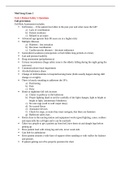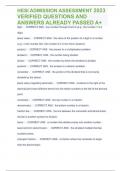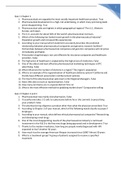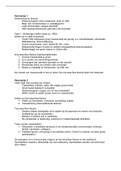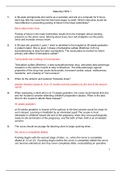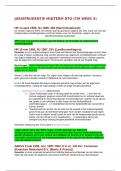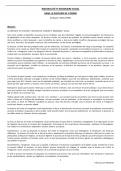Introduction. Los Angeles: Sage. ISBN: 9781529600308.
Table of contents:
Short summary of important topics in criminology
Chapter 1: Introducing the landscapes of criminology
Chapter 2: ‘Theory’ and its uses
Chapter 3: Criminological theory: the causes of crime
Chapter 4: Doing criminological research
Chapter 5: Counting crime
Chapter 6: The politics of law and order
Chapter 7: O enders and victims
Chapter 8: Media and crime
Chapter 9: Punishment
Chapter 10: Social policy and crime
Chapter 11: Global justice
Chapter 12: Moving towards a harms-based approach
ff
, Key topics in criminology:
- Causes of crime: Related to explanations and arguments about why people commit crime, in
terms of individual and social processes, and a consideration of aspects such as decision-
making, biology, psychology, culture, the economy, and so on. Plus, critical ideas related to
power, control and ‘criminalisation’.
- Class, power and inequality: What roles do ‘class’ and inequality play in relation to law and
order issues? Who has ‘power’ in a society, and to what end do they exercise that power?
Many criminologists consider class, power and inequality in the context of thinking about law
and order processes.
- Crime: can be de ned and understood in di erent ways: a common-sense legal de nition
versus a focus on morality, social construction and harm.
- Researching crime and justice issues: Criminologists use a diverse range of tools to gather
information on crime and justice issues.
- Crime statistics: There are multiple ways of measuring crime and other law and order
processes, such as victimisation, fear of crime, and so on.
- Criminalization: Why do some groups interact with the criminal justice system more than
others? Some criminologists focus on how some behaviours and groups become labelled as
‘criminal’.
- Criminal law, criminal justice processes and institutions: What is law and how it is created
are important questions to consider. Some criminologists question the intentions and workings
of aspects of criminal law. The police, prisons, probation and other elements of law and order
processes are in themselves important areas of focus for criminologists.
- Desistance from crime: The processes that move an o ender from an o ending status to a
non-o ending status. The issues of identity and social capital are important in this.
- Di erential experiences of crime and justice: Inequality in relation to o ending, victimisation
and law and order processes are important for criminologists. Class/status, wealth, ethnicity,
gender, religion, sexuality, legal status, age and disability can shape CJS interactions.
- International processes of crime and justice: Crime and justice can no longer be thought
about simply in a ‘local’ way: the world is connected and integrated (globalisation). Aspects of
o ending (and justice) have evolved through the emergence of cyber-crime, organised crime
activity, international policing and law-making.
- Human rights: These are basic and universal rights and freedoms that governments have an
obligation to ensure. Breaches of human rights might be seen in relation to policing,
immigration and terrorism, and mass imprisonment, for example.
- Media and crime: A well-established topic in criminology that considers how law and order
issues are selected by and presented in di erent media forms, and the implications this has for
perceptions and attitudes, and even o ending itself, and policy-making around crime and
justice.
- Politics of law and order: What is viewed as a problem, who is viewed as problematic, and
what ought to be done about it are linked to things beyond the simple, objective reality and
evidence. Politics plays an important role, and ‘penal populism’ is a key idea in this area.
- Responding to crime; punishment and penology: How do we respond to crime and why? We
respond in di erent ways, yet the criminal justice system itself cannot deal with crime in its
entirety, especially when considering wider social in uences on o ending. Patterns of
punishments must also be considered.
- Social justice: Some groups in society face injustice as a consequence of their status,
ethnicity, gender, and so on. Systematic processes of injustice and victimisation (including
‘harms’) are explored by criminologists in relation to sexual exploitation, working conditions,
civic rights, welfare bene ts systems, and so on.
- Types of crime: There are many di erent forms of crime, which are crudely separated into
‘acquisitive’ and ‘expressive’ acts. We can also identify labels such as crimes against the
person, property crime, sexual o ences, and so on, and events such as genocide, cybercrime,
war crime, corporate crime, and so on.
- Victimization: Who are ‘victims’ of crime and how do people become victimised? How is this
experienced, and does it vary between groups, types of crime, and so on?
- Youth justice: The nature of policing, law-making and punishment speci cally in relation to
children. It can often be highly controversial, given the possibility of needlessly criminalising
young people and drawing them into the criminal justice system.
ffff ff ff fi fi ff ff ff ff ff fl ff ff fiff fi
, Chapter 1: Introducing the landscaps of criminology
Criminology is the study of crime, justice, and law and order issues, and the broader dynamics of
societies in terms of informing how those things exist and are experienced. Thus, the social and
cultural context, the political climate, the nature of the economy. Criminology is interdisciplinary:
it draws in the expertise and knowledge of people working across many academic disciplines.
As a student, engaging in criminology requires a range of skills and competencies:
- Finding appropriate materials: using ‘credible’ sources within your work is important.
- Using materials in an appropriate way: it is important to ask where it came from. Criminology
is evidence-driven. This means that claims/arguments need to be supported by evidence (APA).
- Being a critical enquirer/researcher: this means approaching topics, arguments and sources
of material with a natural curiosity for what it tells us, but also what it does not tell us.
- Being a re ective learner: means actively stopping and taking stock of your own learning,
work, skills and skills gaps (tekort), and asking what has gone well and hasn’t.
- Being a pragmatic researcher: this entails approaching issues using di erent approaches and
methods, and thus using the best tools for the task.
- Being digitally competent: increasingly, criminologists must engage with the digital world.
- Being an advocate for change: it is important to want to see positive
change.
Gibbs’ cycle of re ection:
1. Describe what happened in a situation.
2. Consider your feelings and thoughts.
3. Evaluate what was good and bad about the experience.
4. Do an analysis in terms of what sense you can make of the situation.
5. Form a conclusion in terms of what else could you have done.
6. Develop an action plan for what would you now do SMART: you set
actions or targets for improvements that are Speci c, Measurable,
Appropriate/Achievable, Realistic and with a speci c Time attached to it.
The nature of and the workings of criminal justice systems (CJS) is an
important feature of criminology. It is the process through which the state responds to behavior
that it deems (acht) unacceptable. Criminal Justice (strafrecht) is delivered through a series of
stages: charge (aanklacht), prosecution (vervolging), trial, sentence (veroordeling), appeal,
punishment, these processes and the agencies which carry them out are referred to the criminal
justice system.
A common-sense way of talking about crime often entails linking it to law, de ning crime as an
intentional act which breaks or goes against a law. But, only seeing ‘crime’ in that way is very
limited. Criminologists point to a range of problems associated with this legal de nition. Questions
that can be asked are: Where have laws come from, who creates them, and for what purpose?
Laws are also not xed or static. New laws can be made and old laws repealed. This means that
what is understood to be ‘crime’ must also be uid. Also, the decision to criminalize certain
behaviors has to be in uenced by something, such as pressure from the public, changing social
attitudes, and technological developments.
Many damaging behaviors are not criminalized, while some groups in society are seemingly
disadvantaged by the needless criminalization of certain behaviors, such as homosexuality or
abortion in some countries. Often, there is a moral component to how we understand behavior
and whether they are viewed as being problematic. The socially constructed nature of crime
refers to how much of what is viewed as ‘crime’ is a product of the dynamics of a given society at
a given point in time. Deviancy (afwijking) describes acts that are outside the mainstream values
and norms of a society. In the harms-based approach, criminologists consider a range of issues
(e.g., working conditions or health damage) whereby there is clearly harm being carried out
against people and groups that demands some form of attention and action. The more harm
done, the greater the severity of the response required.
fl flfi fl fl fi ff fi fi



